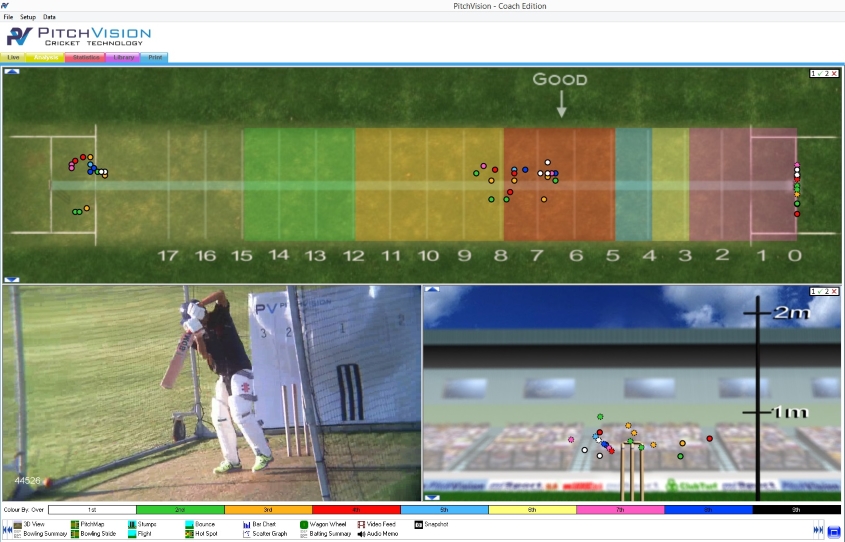|
 The relationship is simple: The better you pick length, the better you are as a batsman. It's, at least, one third of the art of batting. The relationship is simple: The better you pick length, the better you are as a batsman. It's, at least, one third of the art of batting.
Yet, as a coach, I see many players struggle to pick length well. They hit balls in practice all day long and look technically sound. Then they go out in the middle and get caught playing forward to a back of a length ball, and spooning a simple catch up in the air.
People say things like "he's stuck on the crease", "he falls over" and "he's too defensive". While all these comments may be true, they are not the root cause. The root cause is often not picking the ball in time to get into the right position.
Do you recognise these symptoms in yourself?
Here's my solution.
Play by numbers
As you know, I'm a big believer in backing ideas with numbers. Stats play the role of allowing you to accurately track your progress. You just need the right number to examine.
When it come to picking length, it's a tough area to measure. How do you judge what you have been thinking in a split second? The answer is buy using some numbers.
This is exactly what I did with my troubled player. The process is simple:
- In nets, video the player batting
- Note down the length of every ball faced
- Compare the video to length and scored the player on picking the right length based on moving forward or back. A correct movement is a point, incorrect or late movement is no points.
- Give the player a percentage
- Perform some remedial work, and repeat.
- Watch the score shoot up!
To make this easier we used PitchVision for the length tracking. Because the video is integrated, we can easily look at all the ball pitched up, and all the short balls. Then watch the player in another window:

The above image is all the fuller balls in the session. You can see the length on the pitch, the bounce height and the video of the shot. You can see how easy it is to tie technique to the type of ball. Here is the same session filtered by shorter balls instead:

You can even filter by pace and by stage of the net (later in the session bowling gets more erratic and batsmen are more fatigued). Although in this case I looked at the whole session (around 40 balls).
This method provides an ideal feedback loop that has be proven to be the fastest way to develop skill and iron out technical issues.
So, with your loop in place, what drills do you try?
Drills for length selection
The first rule of drilling for length is to stay away from bowling machines as much as possible.
Machines are a wonderful tool, and can be used in this situation, but using throw downs, sidearm or bowlers gives more advantages: You can get in rhythm better, see the whole action rather than just the ball, and the natural variation in length means you can't premeditate your selection.
So, stick to throws or bowlers while you work on this skill.
Next, break your session down into overs. Have an over in the net, then walk out and do a selection drill. Once you have done six balls, go back in. You can alternate with another batsman to keep the bowlers going.
One of the best drills is this one from Chris Nash. It's simplicity means you can do six reps, then go back to the nets and keep repeating the loop.
If you are having a longer hit with no break, another drill is to focus on what you are looking at. Look at this from Mark Garaway to find out more. Don't be afraid to experiment and compare results between the two methods.
Still having issues?
The above drill should make a dramatic difference in a short time. Sometimes you find a player who needs even more granular help. What if you try over a few session and still see little improvement?
Sam Lavery, top coach and member of the PVA Cricket Show team, gave me a more detailed drill for the hard nut to crack.
Break down the feeds even further: face balls that are not only short and full but also different lines. You will find performance is better in different areas. You can then focus in on the specific problem length.
At first, just develop a technical solution for dealing with your weaker areas, then bring decision making back in. So, if you find you struggle with the full ball on leg stump, you can hone your on drive. Then you can get feeds that are either very full or very short on that line. As you pick up confidence, you can adjust the lengths to make it harder. Finally, you can return to more randomised lines and lengths together in an open net.
As always, keep PitchVision tracking your results over time.
If you are suffering from this issue, have heart. It is fixable, even in the most extreme circumstances. You can even sort it out in the middle of the season. So hit the nets win purpose and you will see results.
Discuss this article with other subscribers
|

.jpg)



.jpg)

